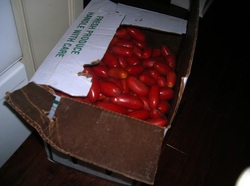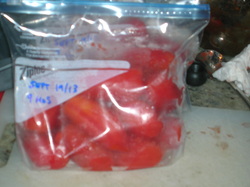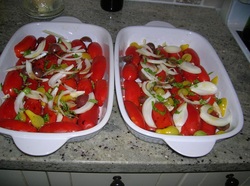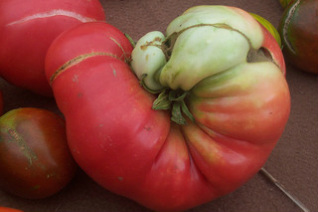
But never mind all that. Over the course of three days last week I processed this parade of sun-warmed Roma magnificence from Highmark Farms in Cookstown, ON.

Here I was proud/exhausted after a short bout of what can only be called “hobby” preserving. Today though, unlike generations past, I have choices. I’m not charged with preserving food to feed my family through a long cold winter. (Isn’t that what Loblaws is for?)
The plan
Like many of you out there, I confess to a fear of canning. I hope I get over it, but this year I chose the straightforward route of freezing. And I chose two methods requiring as little labour as possible:

2) Whole, skinned tomatoes. I also used this recipe from TLC. Tomatoes keep up to nine months in the freezer.
For me, processing was time-consuming but simple work. For the roasted sauce, after the first couple of batches, I doubled my capacity by putting batches on two oven racks. With the blanching method, once I did it a couple of times, I really sped up.
Quantity
All in all, my $25.00 bushel yielded about 20 Ziploc bags of Roma tomatoes (I was aiming for the same amount as a big can), plus roughly 20 cups of sauce. We ate some of the sauce right away, so it’s a little hard to calculate—yum!
Freezer space
Good news for those of you, like me, resisting the urge to buy a chest freezer. I scrounged enough space for a bushel of tomatoes right in my side-by-side. Two shelves are plenty!
Uses
Already, I've used my sauce to make a hearty tomato soup—just add a bit of stock and cream. I’ll also be making pasta sauce, chili, curries and other soups.
Quality
Best of all, what I’ve noticed right away with this tomatoes-gone-wild project, is the depth of flavour you get. With my sauce in particular, roasting at peak freshness has given me such a unique product--you just can't get this in stores. Will I do it again next year? Sign me up. I know the kind of work I’m getting into, but I'm also thrilled by what I get out of it!



 RSS Feed
RSS Feed
